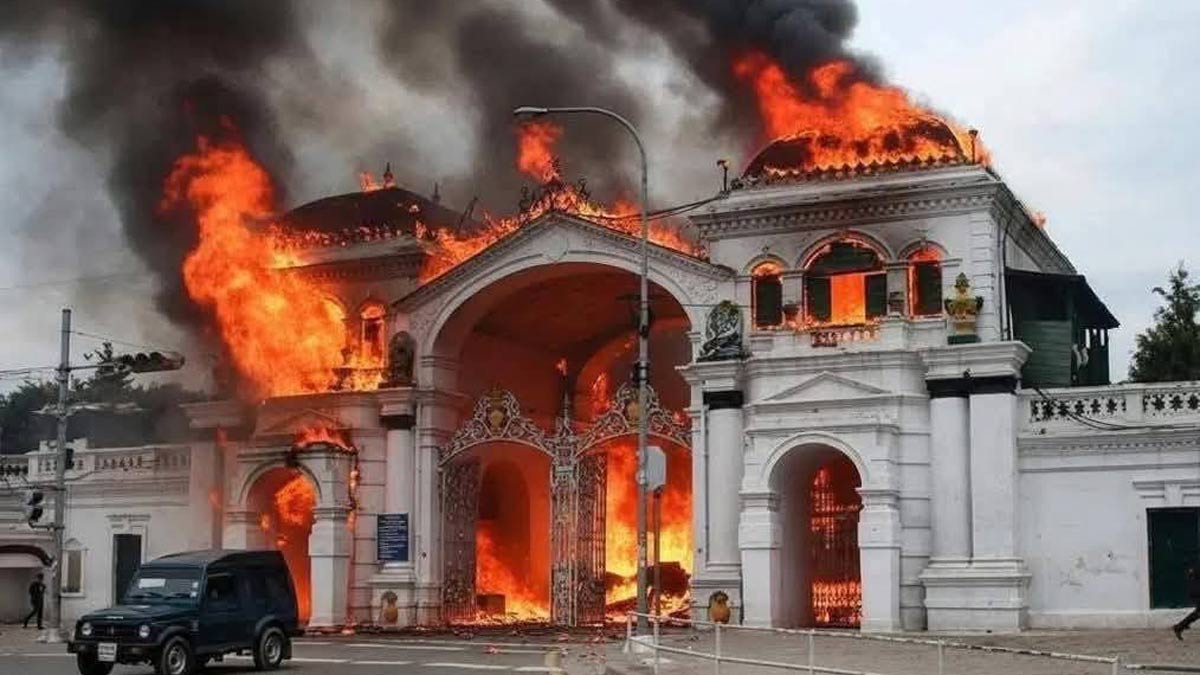Darkest chapter in modern Nepal? With breakdown of law and order, governance, public security, the nation faces uncertainty

Nepal has plunged into an unprecedented crisis as mass anti-corruption and pro-freedom protests spiralled into a full-scale uprising, leaving the country’s key governmental structures in ruins. In just three days—September 8, 9, and 10—protesters have taken over government buildings, torched political party offices, and even stormed the residences of top political leaders.
The unrest was initially sparked by the government’s move to shut down social media platforms. However, the crackdown on digital freedom quickly snowballed into broader demands for an end to rampant corruption, systemic misgovernance, and unaccountable leadership. The government's heavy-handed response, which resulted in the deaths of 19 people in a single day, only added fuel to the fire. The death toll has since risen to 24, with over 1,000 injured.
Core institutions destroyed
The extent of the damage is staggering. All three pillars of the state — the executive, legislative, and judiciary — have suffered irreparable blows. Key administrative buildings, including the historic Singha Durbar (the main government secretariat), have been completely destroyed. The prime minister’s official residence in Baluwatar was set on fire, forcing security forces to evacuate K.P. Sharma Oli to an undisclosed location.
The Office of the President at Sheetal Niwas was also seized and demolished by protesters, prompting President Ram Chandra Paudel to flee under military protection. The Supreme Court, the Office of the Attorney General, and other judicial institutions have been attacked, with critical legal archives reportedly turned to ashes.
Political leadership targeted
Major political figures from the Nepali Congress, CPN-UML, CPN-Maoist Centre, and CPN (Unified Socialist) parties were direct targets. Former prime minister Sher Bahadur Deuba and Foreign Minister Arzu Rana Deuba were attacked at their Budhanilkantha residence, sustaining serious injuries. Protesters reportedly scaled the compound walls to enter the premises, accusing the couple of large-scale corruption.
Former PM Pushpa Kamal Dahal’s residences in both Kathmandu and Chitwan were also attacked, with the latter set ablaze. Jhalanath Khanal’s home was torched, resulting in injuries to his wife. Homes of other senior leaders, including Gagan Thapa and Mohan Basnet, were also burned.
Chaos nationwide
Government institutions, political party headquarters, and even controversial business establishments were torched or taken over. The Parliament building in New Baneshwor was set on fire and now lies in ruins. The Commission for the Investigation of Abuse of Authority (CIAA) was also attacked.
Public infrastructure, including airports, was not spared. Gautam Buddha International Airport in Bhairahawa faced arson attacks, while Tribhuvan International Airport in Kathmandu was shut down amid repeated intrusion attempts by demonstrators.
Even prisons have been breached. In a dramatic escalation, nearly 6,000 inmates reportedly escaped from various jails, including the Central Prison in Sundhara and facilities in Rautahat, Chitwan, Kanchanpur, Jumla, and Baitadi, among others.
Army deployed, martial measures imposed
As police and other security forces failed to contain the chaos, the Nepal Army was deployed across major cities and sensitive sites. However, the military refrained from directly engaging with protesters, allowing many to seize control of public institutions with minimal resistance.
From Tuesday night, security personnel began patrolling streets, urging civilians to stay indoors. Citizens found outdoors without valid reasons were sent back. Only essential workers were permitted to move after identity verification. Emergency services are overwhelmed, with hospitals filled beyond capacity and a dire shortage of ambulances and fire engines.
Looting incidents have also surged. At least 21 individuals have been arrested in connection with theft and violence in the Kathmandu Valley.
A collapse of governance
The situation has pushed Nepal into what many are calling the darkest chapter in its modern history. With the complete breakdown of legal order, governance, and public security, the nation faces uncertainty over what comes next.
Civil society, which played a critical role in maintaining local order during past democratic movements (such as in 1990 and 2006), appears disorganised and inactive. This absence of grassroots coordination has reportedly worsened the scale of destruction and lawlessness.
As the crisis continues to unfold, there is no immediate sign of leadership or reconciliation. The protesters remain defiant, the state remains incapacitated, and Nepal stands at a dangerous crossroads.
(Niranjan kumar Sah is a Kathmandu based freelance journalist)
World